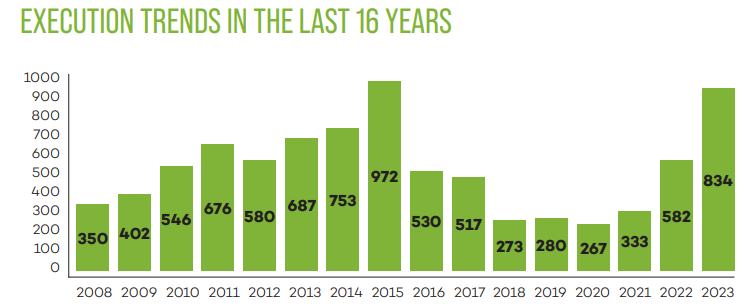Iran executed at least 834 people in 2023, a 43 percent increase compared to 2022, according to the annual report by Iran Human Rights (IHRNGO) and Together Against the Death Penalty (ECPM). Some 56 percent of the executions were drug-related. Marginalized ethnic minorities, such as the Baluch of southeastern Iran, were overrepresented among those executed for drug charges. About a third of executions were for murder charges.

Six people were executed in connection with the nationwide protests sparked by the death of Mahsa Amini – a young woman detained for improper hijab – in policy custody in 2022. “Instilling societal fear is the regime’s only way to hold on to power, and the death penalty is its most important instrument,” IHRNGO Director Mahmood Amiry-Moghaddam said. IHRNGO is based in Norway and ECPM is based in France. The following is an excerpt from the report’s executive summary.
Annual Report on the Death Penalty in Iran: 2023
The 16th Annual Report on the Death Penalty in Iran, by Iran Human Rights (IHRNGO) and Together Against the Death Penalty (ECPM), reveals that the Iranian authorities intensified their use of the death penalty to instill societal fear in the year following the outbreak of the “Woman, Life, Freedom” nationwide protests. The report documents a staggering total of 834 executions in 2023, representing a 43% increase compared to the previous year. This is the second highest number of documented annual executions in more than 20 years in Iran.
Eight protesters were executed in 2023, six of whom were arrested in relation to the “Woman, Life, Freedom” protests and sentenced to death in grossly unfair trials without due process. While executions of the protesters led to strong international reactions in the beginning of the year, the executions in the second half of the year failed to elicit the same level of condemnation and backlash. The correlation between lack of international attention and the use of the death penalty by the Islamic Republic was especially evident after the onset of the war in Gaza on 7 October 2023. The average number of daily executions rose from two people before the onset of the war in Gaza to an average of 3-4 executions per day during the war.
Commenting on the report, Iran Human Rights Director, Mahmood Amiry-Moghaddam said: “The Iranian regime uses the death penalty to prolong its survival. We are dealing with a regime that is oppressive, corrupt and incompetent to solve people’s daily problems. Instilling societal fear is the regime’s only way to hold on to power, and the death penalty is its most important instrument. Increasing the political cost of the executions by international pressure can slow down the regime’s killing machine. The inconsistency in the international community’s reaction to the executions in Iran is unfortunate and sends the wrong signal to the authorities.”
- At least 834 people were executed in 2023, a 43% increase compared to 582 in 2022.
- 125 executions (15%) were announced by official sources, compared to 12% in 2022, 16.5% in 2021 and an average of 33% in 2018-2020.
- 85% of all executions included in the 2023 report, i.e. 709 executions, were not announced by the authorities.
- At least 471 people (56%) were executed for drug-related charges, compared to 256 in 2022, 126 in 2021 and an average of 24 per year in 2018-2020.
- Only 25 (5%) of the 471 drug-related executions were announced by official sources.
- At least 282 executions (33.8% of all executions) were for murder charges.
- At least 39 people, among them 6 protesters and one woman, were executed for security-related charges (moharebeh, baghy and efsad-fil-arz).
- At least 8 protesters were executed. • At least 20 people were executed for rape charges.
- 2 people were executed for blasphemy charges.
- 1 man was executed for adultery charges.
- 7 people were hanged in public spaces.
- At least 2 juvenile offenders were among those executed, one of whom was 17 at the time of execution. Cases of 3 possible others were still being investigated at the time of writing.
- At least 22 women were executed, the highest number since 2013.
- At least 512 executions in 2023 and more than 4,541 executions since 2010 have been based on death sentences issued by the Revolutionary Courts.
- At least 857 prisoners sentenced to death for murder charges were forgiven by the families of the murder victims per qisas laws.
Click here for the full report.
